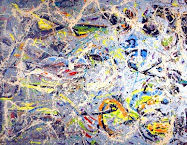
Have some fun, and save money on expensive pastels, by making some of your own sticks. It's easier than one may have heard. Some of the information online is positively frenetic with how complex and difficult it should be. Don't believe it!
I will link to the super-secret and classified extra special and need-to-know web page that will provide you, a commoner and civilian, with the ultra evil and never before revealed magic formula that will de-mystify and reveal HOW TO MAKE ONE'S OWN PASTELS! Keep it under your hat, and reveal this to no one. Eat the instructions when you have completed your mission.
Are you on the edge of your seat? Good. Let's begin by gathering our tools and supplies. At first, you can even participate without buying anything expensive in the way of art supplies. Let's look at my photo of materials, but keep in mind that it is inclusive of the most supplies that you may want. For this basic session, you will only need items # 1, 2, 5, 6 and 7.
Gather the following:
- The bits and pieces of broken pastels that are too small to use anymore. Seen at the left side of the photo in a dish is a broken yellow Diane Townsend, and in the little cardboard box are some mixed color bits and pieces.
- In the glass jar are the tailings from my easel, all colors. I keep a length of mat board, shaped in a "V", on the easel tray and under my artwork. Then, it gathers the dust that falls, and I pour it (hold your breath) into a jar.
- Also note two jars of store-bought pigment (optional: you can make pastels for now without these). This is expensive stuff. However, the quantity of pastel sticks that one can make by hand would set you back much more if you were to buy them on the retail market. It is the same pigment that goes into every colored thing on the planet: automobiles, oil paint, printer cartridges, etc. Pigment is pigment. These are powdered (which is pigment's original form) and are sold for artist's use in making paint, pastels, etc.
- (Optional at this time) The white bags are various products to add to your pigments as "body" and/or binders when we start making our own new colors. From left to right: Titanium White (Black will be in a jar like the other pigments), Whiting, Gum Tragacanth, French Chalk (Talc), and Pumice Powder. These represent more Additives than you will need for the most basic pastel making.
- I use a glass surface for my mixing and paste rolling. This circular piece of glass was surplussed (free) from a retail-supply store. If you live in Italy, the glass may be substituted with marble, which is cheaper than dirt in your mountainous country. Be creative and use whatever is easy to clean between different color mixings.
- (Not Shown) A smallish spray bottle to meter out your water in a measured way.
- Dust masks, latex gloves, paper towels, and Windex (spray glass-cleaner). You might want to resource a shop apron, and you will need old clothes and dedicated footwear (old tennis shoes, or rubber boots). Everything will launder-up fine, though.
Since my time is cramped, today, I'll let you just get these things together and go with the actual making pastels, complete with links, in my next installment.




















No comments:
Post a Comment